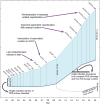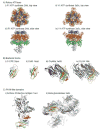SCOPe: Manual Curation and Artifact Removal in the Structural Classification of Proteins - extended Database
- PMID: 27914894
- PMCID: PMC5272801
- DOI: 10.1016/j.jmb.2016.11.023
SCOPe: Manual Curation and Artifact Removal in the Structural Classification of Proteins - extended Database
Abstract
SCOPe (Structural Classification of Proteins-extended, http://scop.berkeley.edu) is a database of relationships between protein structures that extends the Structural Classification of Proteins (SCOP) database. SCOP is an expert-curated ordering of domains from the majority of proteins of known structure in a hierarchy according to structural and evolutionary relationships. SCOPe classifies the majority of protein structures released since SCOP development concluded in 2009, using a combination of manual curation and highly precise automated tools, aiming to have the same accuracy as fully hand-curated SCOP releases. SCOPe also incorporates and updates the ASTRAL compendium, which provides several databases and tools to aid in the analysis of the sequences and structures of proteins classified in SCOPe. SCOPe continues high-quality manual classification of new superfamilies, a key feature of SCOP. Artifacts such as expression tags are now separated into their own class, in order to distinguish them from the homology-based annotations in the remainder of the SCOPe hierarchy. SCOPe 2.06 contains 77,439 Protein Data Bank entries, double the 38,221 structures classified in SCOP.
Keywords: database; protein evolution; structure classification.
Copyright © 2016 The Author(s). Published by Elsevier Ltd.. All rights reserved.
Figures


Similar articles
-
SCOPe: Structural Classification of Proteins--extended, integrating SCOP and ASTRAL data and classification of new structures.Nucleic Acids Res. 2014 Jan;42(Database issue):D304-9. doi: 10.1093/nar/gkt1240. Epub 2013 Dec 3. Nucleic Acids Res. 2014. PMID: 24304899 Free PMC article.
-
SCOPe: classification of large macromolecular structures in the structural classification of proteins-extended database.Nucleic Acids Res. 2019 Jan 8;47(D1):D475-D481. doi: 10.1093/nar/gky1134. Nucleic Acids Res. 2019. PMID: 30500919 Free PMC article.
-
SCOPe: improvements to the structural classification of proteins - extended database to facilitate variant interpretation and machine learning.Nucleic Acids Res. 2022 Jan 7;50(D1):D553-D559. doi: 10.1093/nar/gkab1054. Nucleic Acids Res. 2022. PMID: 34850923 Free PMC article.
-
The SUPERFAMILY database in structural genomics.Acta Crystallogr D Biol Crystallogr. 2002 Nov;58(Pt 11):1897-900. doi: 10.1107/s0907444902015160. Epub 2002 Oct 21. Acta Crystallogr D Biol Crystallogr. 2002. PMID: 12393919 Review.
-
Lessons from making the Structural Classification of Proteins (SCOP) and their implications for protein structure modelling.Biochem Soc Trans. 2016 Jun 15;44(3):937-43. doi: 10.1042/BST20160053. Biochem Soc Trans. 2016. PMID: 27284063 Free PMC article. Review.
Cited by
-
Progressive and accurate assembly of multi-domain protein structures from cryo-EM density maps.bioRxiv [Preprint]. 2020 Oct 16:2020.10.15.340455. doi: 10.1101/2020.10.15.340455. bioRxiv. 2020. Update in: Nat Comput Sci. 2022 Apr;2(4):265-275. doi: 10.1038/s43588-022-00232-1. PMID: 33083802 Free PMC article. Updated. Preprint.
-
Protein folds as synapomorphies of the tree of life.Evolution. 2022 Aug;76(8):1706-1719. doi: 10.1111/evo.14550. Epub 2022 Jul 13. Evolution. 2022. PMID: 35765784 Free PMC article.
-
Trichomonas vaginalis metalloproteinase TvMP50 is a monomeric Aminopeptidase P-like enzyme.Mol Biotechnol. 2018 Aug;60(8):563-575. doi: 10.1007/s12033-018-0097-0. Mol Biotechnol. 2018. PMID: 29936696
-
Structure-based prediction of ligand-protein interactions on a genome-wide scale.Proc Natl Acad Sci U S A. 2017 Dec 26;114(52):13685-13690. doi: 10.1073/pnas.1705381114. Epub 2017 Dec 11. Proc Natl Acad Sci U S A. 2017. PMID: 29229851 Free PMC article.
-
Protodomains: Symmetry-Related Supersecondary Structures in Proteins and Self-Complementarity.Methods Mol Biol. 2019;1958:187-219. doi: 10.1007/978-1-4939-9161-7_10. Methods Mol Biol. 2019. PMID: 30945220 Free PMC article.
References
Publication types
MeSH terms
Substances
Grants and funding
LinkOut - more resources
Full Text Sources
Other Literature Sources

